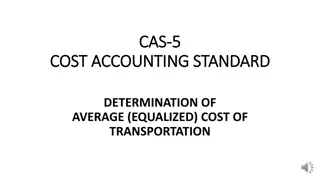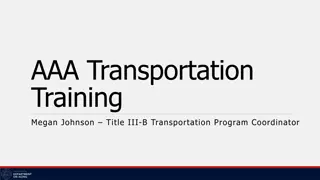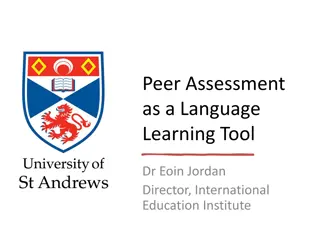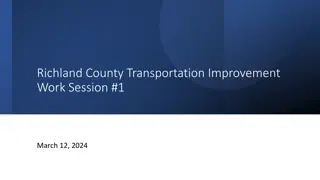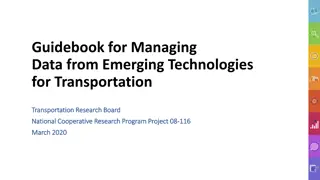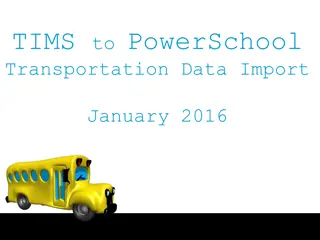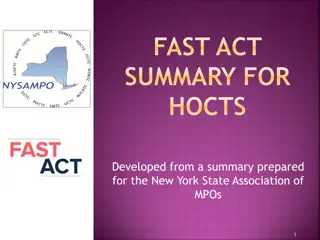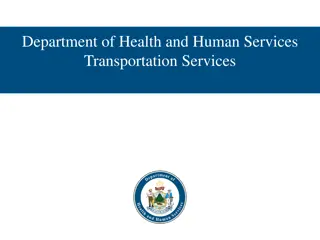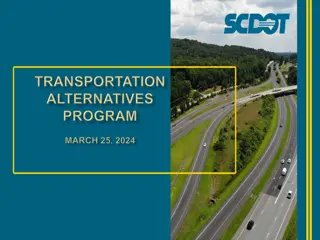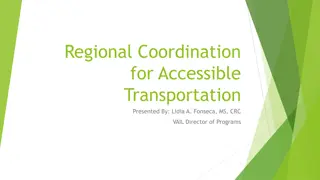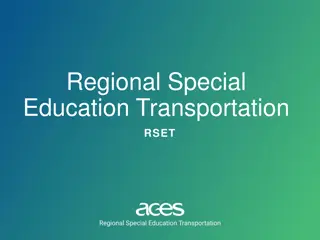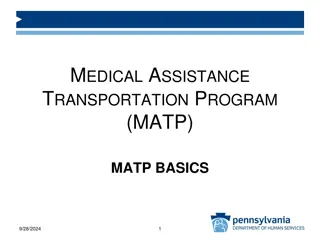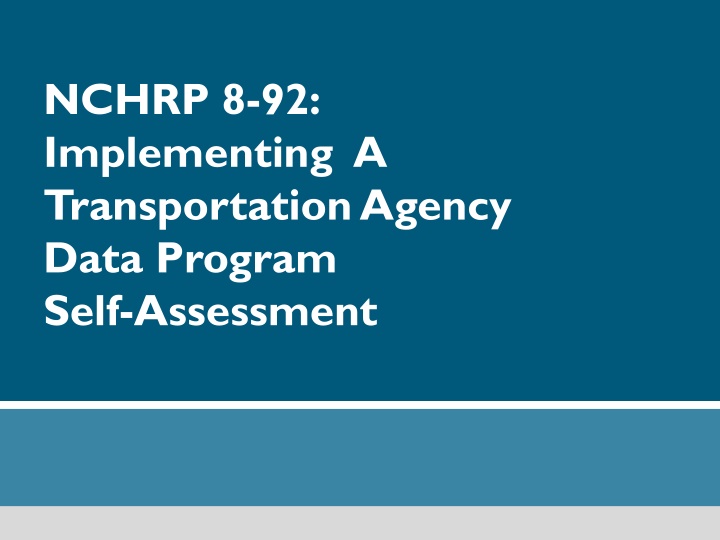
Implementing a Transportation Data Self-Assessment
A methodology, guide, and tools to help transportation agencies assess data quality, efficiency, and value, enabling data-driven decisions and maximizing data investments.
Download Presentation

Please find below an Image/Link to download the presentation.
The content on the website is provided AS IS for your information and personal use only. It may not be sold, licensed, or shared on other websites without obtaining consent from the author. If you encounter any issues during the download, it is possible that the publisher has removed the file from their server.
You are allowed to download the files provided on this website for personal or commercial use, subject to the condition that they are used lawfully. All files are the property of their respective owners.
The content on the website is provided AS IS for your information and personal use only. It may not be sold, licensed, or shared on other websites without obtaining consent from the author.
E N D
Presentation Transcript
NCHRP 8-92: Implementing A Transportation Agency Data Program Self-Assessment
What is a Transportation Data Self What is a Transportation Data Self- - Assessment? Assessment? A methodology, guide and tools to help agencies answer four key questions: Do we have the right data to make good decisions and meet reporting requirements? What data do we need and why? Is our current data good enough? What level of accuracy, timeliness, completeness, etc. is needed? Are we making best use of our data collection and management resources? Are we being efficient about how we collect and manage the data? Are we getting full value from the data that we have? Are users able to access, integrate and analyze it? 2
Why Conduct the Self Why Conduct the Self- - Assessment? Assessment? Data is an essential transportation agency asset Transportation agencies are increasingly data driven Data needs are growing in number and complexity Performance management Asset management System operations and traveler information Data is expensive to collect and maintain Important to derive full value from data investments Systematically identify opportunities to improve efficiencies and adjust the data portfolio to better meet agency needs 3
Operationalizing AASHTOs Data Operationalizing AASHTO s Data Principles Principles Data Principle 1. VALUABLE: Data is an asset 2. AVAILABLE: Data is open, accessible, transparent and shared 3. RELIABLE: Data quality and extent is fit for a variety of applications 4. AUTHORIZED: Data is secure and compliant with regulations 5. CLEAR: There is a common vocabulary and data definition 6. EFFICIENT: Data is not duplicated 7. ACCOUNTABLE: Decisions maximize the benefit of the data Transportation agencies adopting these principles and putting them into action should realize steady improvements to data value, and an increased return on their data investments. 4
Benefits of a Data Self Benefits of a Data Self- -Assessment Assessment MOVE FROM: Data as a burden Seat of the pants decisions We don t trust the data We don t have that information Multiple inconsistent answers to your question Multiple uncoordinated data silos TO: Data as an asset Data-driven decisions We rely on the data Look that up on your dashboard One single authoritative answer to your question Integrated data systems 5
Without Strong Data Management Without Strong Data Management Data may be collected but not well utilized because of insufficient quality, access or documentation Data may not be easily integrated to provide for meaningful analysis Data may be duplicated resulting in inefficiencies, inconsistencies and conflicting information Data may be collected that no longer adds value while other more pressing data needs go unmet Staff resources may lack tools and systems to effectively and efficiently respond to critical information requests 6
Background on NCHRP 8 Background on NCHRP 8- -92 92 The NCHRP 8-92 project included: A literature review of strong data assessment methods and frameworks Interviews with state and regional transportation executives and AASHTO and US DOT representatives Focus groups in five state transportation agencies Colorado, Kentucky, Maryland, Minnesota and Oregon Case studies in two state transportation agencies Utah and Michigan piloted the data value and data management assessment tools at several business area levels and at an enterprise level 7
NCHRP 8 NCHRP 8- -92 Research Results 92 Research Results The NCHRP 8-92 project resulted in: A refined model and methodology for conducting agency data self-assessments A Guide that provides step-by-step guidance for agencies wishing to do transportation data-self assessments A set of assessment tools for gauging the maturity of data management practices and the quality of data for meeting business functions Examples of what agencies can do to step up and advance data management maturity levels and the value that can be derived from such actions 8
Assessment Overview Assessment Overview The data self-assessment framework features two assessment tools to examine current needs and practices: Data Value Assessment assesses the degree to which data users feel that data are providing value and meeting business needs Data Asset Management Maturity Assessment assesses the current level of agency capabilities for managing data assets to maximize their value 9
Assessment Process Assessment Process Prepare Assemble Team Establish Goals Set Scope and Timeline Assess Improve and Monitor Consolidate list of initiatives and recommendations Prioritize improvements Update action plan Track progress Data value Business area assessments Data management Agency wide assessment Data-specific assessments 10
Data Value Elements Data Value Elements Element Rating Data availability are data available at the right level of detail, with sufficient coverage? Poor. Little or no data available to support this activity Fair. Limited data available - large gaps remain Good. Basic data are available - some gaps remain Excellent. Sufficient data are available to meet needs Data quality are data sufficiently accurate, credible and current to support decision making? Poor. Quality not sufficient data not useful Fair. Lack of currency, reliability or completeness limits value Good. Acceptable but needs improvement Excellent. Sufficient to meet needs Usability can data be easily integrated, analyzed and presented as needed to support decision making? Poor. Requires substantial effort to get data into usable form Fair. Requires moderate effort to get data into usable form Good. In usable form but reporting improvements helpful Excellent. In usable form, no improvement needed 12
Data Value Sample Results Data Value Sample Results Business Area Availability Quality Usability Maintenance Management Good Fair Fair Pavement Management Excellent Good Good Safety Planning Excellent Good Fair Performance Management Fair Fair Good Project Scoping Good Fair Good Construction Management Good Good Fair Corridor Planning Good Good Poor 13
Data Value Data Value Results Results Sample Gaps Sample Gaps Type of Data Gaps Business Impacts Maintenance Work History Availability: We need historical information for budgeting, but we only have aggregate expenditures, not costs by activity Quality: Sign inventory is 3 years old and doesn t reflect recent work done Better data would improve ability to link budget estimates with expected outputs Sign Inventory Districts won t use the inventory because they don t trust the data. They will spend time re-collecting data. Traffic Usability: We must submit a request to IT in order to get the traffic data reports we need Strains IT resources and limits business value of the data 14
Data Management Assessment Data Management Assessment Elements Elements Data Strategy and Governance: how decisions are made about what data to collect and how to manage and deliver it -- including roles, accountability, policies and processes. Life-Cycle Data Management: how data are maintained, preserved, protected, documented and delivered. Data Architecture and Integration: practices to standardize and integrate data to minimize duplication and inconsistencies, including spatial referencing Data Collaboration: processes to coordinate data collection and management with internal and external users Data Quality Management: practices to define, validate, measure and report data quality 15
Data Management Maturity Levels Data Management Maturity Levels Maturity Level Name 1 Initial Definition Processes, strategies and tools are generally ad-hoc rather than proactive or enterprise-wide; successes are due to individual efforts Widespreadawarenessof more mature data management practices; recognition of the need to improve processes, strategies and tools Processes, strategies and tools have been developed, agreed- upon and documented Processes, strategies and tools are generally being implemented as defined Strategies, processes and tools are routinely evaluated and improved 2 - Developing 3 - Defined 4 Functioning 5 Optimizing 16
Example: Data Quality Example: Data Quality Level 1 Initial 2 - Developing Definition Data quality is addressed on an ad-hoc basis in response to reported issues. There have been some efforts to work with data users to proactively discuss and define data quality requirements. Standard practices are being defined. Standard, documented data quality assurance and improvement processes are defined. Business rules for assessing data validity have been defined. Specific guidance and procedures for data collection and processing is routinely provided to ensure consistency. 4 Functioning Standard, documented data quality assurance processes are routinely followed. Data collection personnel are trained and certified based on demonstrated understanding of standard practices. Business rules for data validity are built in to applications. 5 Sustained Data quality assurance processes are regularly assessed and improved. Automated error reporting tools are available for data users. Data validation and cleansing tools are used to identify and address missing or invalid values. 3 - Defined 17
Benefits of Moving Up the Maturity Scale Benefits of Moving Up the Maturity Scale Agency data can be used as intended and can be used to produce reliable information that is valuable for decision making because: Data quality is addressed proactively, using standard quality control and quality assurance processes Data are validated based on established business rules Data cleansing processes are automated Efficient error reporting and correction processes are in place 18
Data Management Data Management Sample Results Sample Results Data Program Strategy & Governance Life Cycle Mgt. Arch.& Integration Collab- oration Quality Overall Level Agency-wide 2-Developing 3-Defined 2-Developing 2-Developing Not Assessed 2-Developing Traffic Monitoring 3-Defined 4-Functioning 3-Defined 5-Sustained 4-Functioning 4-Functioning Crash Data 5-Sustained 4-Functioning 3-Defined 5-Sustained 4-Functioning 4-Functioning Pavement Inspection 1-Initial 4-Functioning 3-Defined 1-Initial 5-Sustained 3-Defined STIP/Capital Projects 3-Defined 5-Sustained 1-Initial 2-Developing 2-Developing 3-Defined Financial 5-Sustained 5-Sustained 4-Functioning Not Assessed 4-Functioning 4-Functioning 19
Data Management Data Management Sample Gaps Sample Gaps Assessment Element Gaps Business Impacts Data Strategy and Governance Accountability for data hasn t been established. Data aren t meeting user needs. Data Architecture and Integration Coding for districts and jurisdictions hasn t been standardized across data sets. Takes a lot of manual effort to integrate different data sets to provide value for management decisions Data Collaboration Several different districts are independently collecting the same type of data. Missed opportunity for a more efficient statewide approach Data Quality Pavement data are being collected without an established QA process Districts don t trust the data and are reluctant to use it 20
Data Improvements: Strategy Data Improvements: Strategy and Governance and Governance Data Governance Bodies Data Governance and Stewardship Policies Data Business Plans Data Management Roles and Responsibilities Data Value Mapping Data Communities of Interest 21
Data Improvements: Life Cycle Data Improvements: Life Cycle Management Management Standard Operating Procedures Data Change Management Data Catalogs and Dictionaries Data Curation Profiles Data Management Plans Data Retention Schedules and Archiving Data Access Policies Data Delivery Platforms 22
Data Improvements: Architecture and Data Improvements: Architecture and Integration Integration Common Geospatial Referencing Standardized Approach to Temporal Data Reference Data Management Master Data Management Data Architecture Practices and Roles Business Glossaries Data Integration Tools 23
Data Improvements: Data Data Improvements: Data Collaboration Collaboration Multi-Purpose Data Collection Data Clearinghouses/Open Data Platforms Data Partnerships Data Sharing Agreements Data Outsourcing 24
Data Improvements: Data Quality Data Improvements: Data Quality Data Quality Metrics Data Validation Rules Data Cleansing Data Collection Quality Management Processes 25
The Self The Self- -Assessment Process is Flexible Assessment Process is Flexible Conduct the data management assessment at an enterprise level Conduct the data management assessment for one or more data management areas (e.g. traffic or maintenance) Conduct the data value assessment in one or more business areas Conduct a combination of data value and data management assessments for a logical cluster of business functions and data types Pursue a comprehensive agency-wide approach using all of the above for priority business areas or data categories 26
The Self The Self- -Assessment Process Recognizes Assessment Process Recognizes Resource Limitations Resource Limitations Resources for data improvements are limited staff, expertise, money and time All data wants and needs cannot be met It is not necessarily cost-effective to be at the highest maturity level for any given data management element Self-Assessment Process encourages agencies to be selective and prioritize actions based on support for agency priorities and risks of not taking action 27
Conclusion Conclusion The Transportation Data Self-Assessment can help agencies to: Understand how well their data is working for them Understand what investments in data are not paying off and why Make strategic investments to get data programs in alignment with current and future agency priorities Focus and strengthen data management roles, structures, policies, practices and processes to minimize risks and improve efficiencies Periodically check on the progress of improvements and readjust as needed 28


